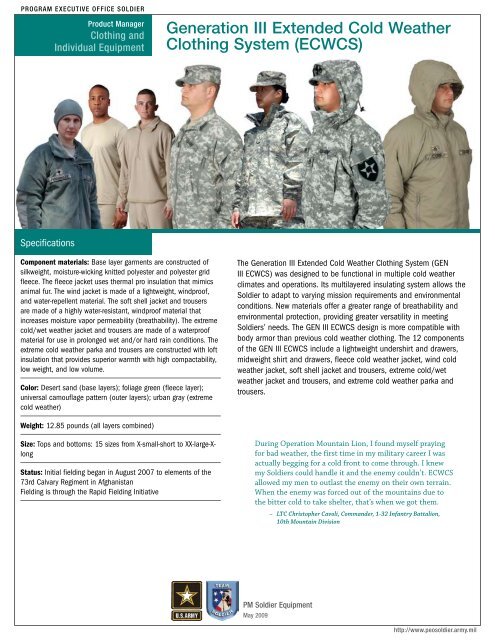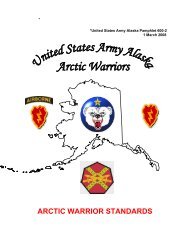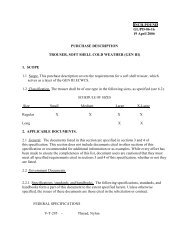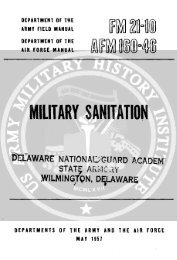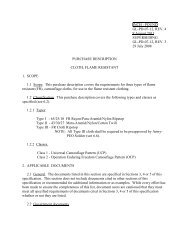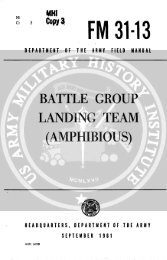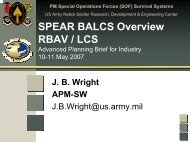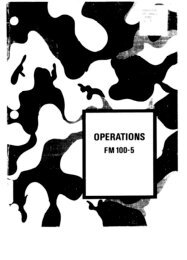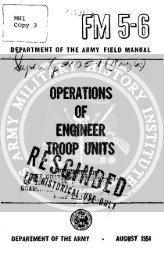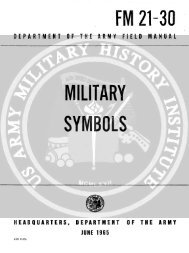Generation III Extended Cold Weather Clothing System ... - CIE Hub
Generation III Extended Cold Weather Clothing System ... - CIE Hub
Generation III Extended Cold Weather Clothing System ... - CIE Hub
Create successful ePaper yourself
Turn your PDF publications into a flip-book with our unique Google optimized e-Paper software.
PROGRAM EXECUTIVE OFFICE SOLDIER<br />
Product Manager<br />
<strong>Clothing</strong> and<br />
Individual Equipment<br />
<strong>Generation</strong> <strong>III</strong> <strong>Extended</strong> <strong>Cold</strong> <strong>Weather</strong><br />
<strong>Clothing</strong> <strong>System</strong> (ECWCS)<br />
Specifications<br />
Component materials: Base layer garments are constructed of<br />
silkweight, moisture-wicking knitted polyester and polyester grid<br />
fleece. The fleece jacket uses thermal pro insulation that mimics<br />
animal fur. The wind jacket is made of a lightweight, windproof,<br />
and water-repellent material. The soft shell jacket and trousers<br />
are made of a highly water-resistant, windproof material that<br />
increases moisture vapor permeability (breathability). The extreme<br />
cold/wet weather jacket and trousers are made of a waterproof<br />
material for use in prolonged wet and/or hard rain conditions. The<br />
extreme cold weather parka and trousers are constructed with loft<br />
insulation that provides superior warmth with high compactability,<br />
low weight, and low volume.<br />
Color: Desert sand (base layers); foliage green (fleece layer);<br />
universal camouflage pattern (outer layers); urban gray (extreme<br />
cold weather)<br />
The <strong>Generation</strong> <strong>III</strong> <strong>Extended</strong> <strong>Cold</strong> <strong>Weather</strong> <strong>Clothing</strong> <strong>System</strong> (GEN<br />
<strong>III</strong> ECWCS) was designed to be functional in multiple cold weather<br />
climates and operations. Its multilayered insulating system allows the<br />
Soldier to adapt to varying mission requirements and environmental<br />
conditions. New materials offer a greater range of breathability and<br />
environmental protection, providing greater versatility in meeting<br />
Soldiers’ needs. The GEN <strong>III</strong> ECWCS design is more compatible with<br />
body armor than previous cold weather clothing. The 12 components<br />
of the GEN <strong>III</strong> ECWCS include a lightweight undershirt and drawers,<br />
midweight shirt and drawers, fleece cold weather jacket, wind cold<br />
weather jacket, soft shell jacket and trousers, extreme cold/wet<br />
weather jacket and trousers, and extreme cold weather parka and<br />
trousers.<br />
Weight: 12.85 pounds (all layers combined)<br />
Size: Tops and bottoms: 15 sizes from X-small-short to XX-large-Xlong<br />
Status: Initial fielding began in August 2007 to elements of the<br />
73rd Calvary Regiment in Afghanistan<br />
Fielding is through the Rapid Fielding Initiative<br />
During Operation Mountain Lion, I found myself praying<br />
for bad weather, the first time in my military career I was<br />
actually begging for a cold front to come through. I knew<br />
my Soldiers could handle it and the enemy couldn’t. ECWCS<br />
allowed my men to outlast the enemy on their own terrain.<br />
When the enemy was forced out of the mountains due to<br />
the bitter cold to take shelter, that’s when we got them.<br />
– LTC Christopher Cavoli, Commander, 1-32 Infantry Battalion,<br />
10th Mountain Division<br />
PM Soldier Equipment<br />
May 2009<br />
http://www.peosoldier.army.mil
Product Manager<br />
<strong>Clothing</strong> and<br />
Individual Equipment<br />
ECWCS Increases Survivability and<br />
Comfort, Helps Troops Outlast the Enemy<br />
Among the many challenges American and allied Soldiers face in Afghanistan, one they have had little control<br />
over is the weather. Depending upon the season, the temperature in the rugged mountain nation can range from<br />
minus 20 degrees Fahrenheit to well above 100 degrees Fahrenheit.<br />
Now, with the <strong>Generation</strong> <strong>III</strong> <strong>Extended</strong> <strong>Cold</strong> <strong>Weather</strong> <strong>Clothing</strong> <strong>System</strong> (GEN <strong>III</strong> ECWCS), Soldiers are getting<br />
the help they need from their equipment. GEN <strong>III</strong> ECWCS, which was designed based on clothing used by<br />
mountaineering professionals, is being distributed through the Rapid Fielding Initiative to all Soldiers deploying<br />
to Iraq and Afghanistan.<br />
The system provides Soldiers with a survivability advantage while operating in multiple cold weather climates and activities. With layered clothing<br />
systems based on principles of insulation, layering, and ventilation, it represents a large leap forward in extreme climate operations. The 12-piece,<br />
seven-layer system allows Soldiers to dress up or down to their individual comfort levels to accomplish their missions in extremely cold climates<br />
without risk of hypothermia or overheating when activity levels rise.<br />
The harsh winter is a particular challenge, and ECWCS has met the challenge, according to overwhelmingly positive feedback from Soldiers who<br />
have used it. Operating in the cold is tough on troops: The going is slower, and it takes more time to perform tasks. Strength ebbs faster; so does<br />
concentration. It is essential to stay dry and warm.<br />
SGT Franklin Hayes, who was deployed to Afghanistan with the 10th Mountain Division, spent a week walking from one village to another where his<br />
unit was setting up a base. “It was a very good system because it gave us different layers to be able to change with the environment as opposed<br />
to just throwing on an overcoat regardless of how cold it was,” Hayes said.<br />
Going from wet to cold to wet and cold really put the ECWCS system to the test. Its inner layers retain heat but draw perspiration away from the<br />
skin. The outer layer lets perspiration evaporate while repelling water. These features, according to Hayes, proved especially useful when sweaty<br />
Soldiers on patrol needed to stay warm and sleep for a couple of hours. “As our bodies started to cool down we would get really cold because<br />
we were wet, so we could put layers on as we needed them,” Hayes said.<br />
The 12 components of GEN <strong>III</strong> ECWCS provide Soldiers clothing with greater breathability and environmental protection, and compatibility with<br />
Interceptor Body Armor (IBA), compared with previous ECWCS systems. The GEN <strong>III</strong> ECWCS system includes a lightweight undershirt and drawers,<br />
midweight shirt and drawers, fleece jacket, wind jacket, soft shell jacket and trousers, extreme cold/wet weather jacket and trousers, and extreme<br />
cold weather parka and trousers. Each layer can accommodate rank, name, and U.S. Army tapes, using a hook-and-loop system.<br />
The clothing enables Soldiers to adapt more readily to varying mission requirements and environmental conditions ranging between minus 40 to<br />
plus 60 degrees Fahrenheit.<br />
Each piece in the ECWCS fits and functions either alone or together as a system to provide the most options for the Soldier, enabling seamless<br />
integration with load carriage equipment and body armor. Hayes said the system “worked well with the IBA. We didn’t have any issues with it, even<br />
with the loft suit. It doesn’t really change your mobility at all.”<br />
Of the wind jacket, SGT Hayes said, “Whenever there was going to be a storm you always wanted to have it with you. .... We had a sandstorm pop<br />
up—they come up out of nowhere. Along with it came torrential downpours, and we were stuck out in the middle of a mountain range. It kept us<br />
pretty dry considering basically having buckets of water dumped on us, but it also kept us warm, especially afterward.”<br />
The advantage of the GEN <strong>III</strong> ECWCS clothing cannot be underestimated. It changes the way Soldiers can fight and enables them to take the fight<br />
to the enemy. The Army’s Project Manager <strong>Clothing</strong> and Individual Equipment, part of Program Executive Office (PEO) Soldier, sought significant<br />
feedback from Soldiers and industry to develop this integrated cold weather system.<br />
The Soldiers operating under LTC Christopher Cavoli, Commander, 1-32 Infantry Battalion, 10th Mountain, were among the first to receive the<br />
GEN <strong>III</strong> system and test it in the combat environment, and the results were dramatic, Cavoli said, “During Operation Mountain Lion, I found myself<br />
praying for bad weather, the first time in my military career I was actually begging for a cold front to come through. I knew my Soldiers could<br />
handle it and the enemy couldn’t. ECWCS allowed my men to outlast the enemy on their own terrain. When the enemy was forced out of the<br />
mountains due to the bitter cold to take shelter, that’s when we got them.” The 10th Mountain Division field-tested 18,000 GEN <strong>III</strong> ECWCS systems<br />
in Afghanistan in the fall of 2006 and winter of 2007.<br />
Now, U.S. Army Soldiers equipped with GEN <strong>III</strong> ECWCS and fighting Taliban insurgents count on the weather, if not as a friend, at least as a<br />
potential ally.


